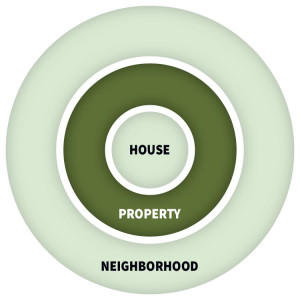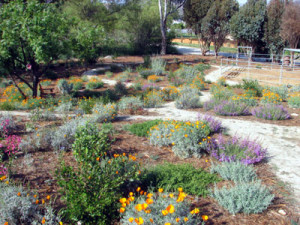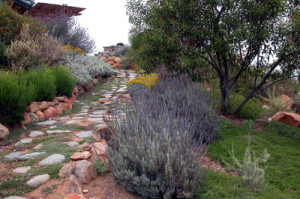 Once you have taken steps to fireproof your house, the next level of preparation is protecting the land surrounding your house. Fireproof your property by:
Once you have taken steps to fireproof your house, the next level of preparation is protecting the land surrounding your house. Fireproof your property by:
- removing flammable objects, and
- creating a defensible space of hydrated and maintained natural vegetation.
There are conflicting opinions about what kind of defensible space will most effectively fireproof your property. Clearing vegetation down to the dirt has been shown to accelerate the spread of wildfire. Removing native vegetation can cause non-native grasses to take over, which dry out quickly and are highly flammable.
Proper landscaping, on the other hand, has been shown to PROTECT a home from burning.
“Maintaining low-growing, hydrated groundcovers and shrubs disrupts and cools the otherwise uninterrupted flow of fire. Allowing thinned and maintained natural vegetation to remain, in addition to irrigated landscape plantings may, in fact, help prevent structures from igniting.” – Greg Rubin and Lucy Warren, The California Native Landscape: The Homeowner’s Design Guide to Restoring Its Beauty and Balance

The emphasis is on HYDRATED, and MAINTAINED. The drier the plant, the more likely it will burn. You have to keep your plants moist, space them appropriately, and remove weeds and dead branches.
“Having well maintained and lightly irrigated vegetation within the outer 70 foot portion of the defensible space zone can play an important role in protecting the home from flying embers and radiant heat. Bare earth clearance creates a bowling alley for embers and can actually increase fire risk if invaded by flammable, non-native weeds.” – Richard Halsey
Here is a Greg Rubin’s observation of the 2007 fires in San Diego County:
“The lightly hydrated native plantings did GREAT, while neighbors with red apple, myoporum, and ice plant sometimes had damaged homes and burned up hillsides. I think that one of the reasons we didn’t lose a single home that we landscaped is that the light summer watering we advocate really hydrates the native plants (and it takes so little water to hydrate a native and they hang on to it even in flames). They smolder and singe but don’t burn intensely and are defensible. The non-natives often appear to lose all their moisture and then burn up (not in all cases).
“I really hope to impress upon agencies that fire resistance is much more about appropriate hydration and not about plant lists. Some of the plants that are looked upon as “fire-bombs” were often the ones that benefited the most and burned the least with supplemental irrigation (think Buckwheat and Sage). The amount of water required is so little that it really ends up being the equivalent of a summer thunderstorm 2-3 times per month. I can’t tell you how gratifying it is to see your customer’s home still standing in the sad midst of burned out homes.”

Native plants have adapted to our dry climate. They retain moisture long after many non-native plants have dried out. They are also ideal plants because they are naturally pest-resistant, so they often don’t need pesticides, and you never need to fertilize them. They also support local wildlife, and are very low-maintenance.
If you want to conserve water, avoid using chemicals in your garden, attract lots of birds, and help to fireproof your property, a native garden is a great choice.
Photos of native gardens and how they stood up to wildfires
Plants that have been shown to be highly flammable, and belong on every DO NOT PLANT list:
- Eucalyptus Trees
- Pampas Grass
- Common Iceplant
- Low-growing Acacia
- Mexican Fan Palms
Here’s a helpful yard checklist from Kay Stewart (Measure from your home and your neighbors’ home):
- No fabric awnings attached to house
- Flammable pet houses 15’ from house
- Wood play structures 15’ from house
- Cloth umbrella, hammock 15’ away from house
- Non-combustible fence first 5’ by house
- Non-combustible fence by fire break
- Clean out any dead plant material inside hedges, and remove all dead leaves and branches from landscape
- No wood mulch within 5’ of a house
- Flammable storage 25’ from house in shed
- Outfit sheds with sealed windows, doors and roof
- Keep plants hydrated
- Trees within 10’ of your house – and prune any branches under 6’ from the ground
- Under trees, no plants over 2’ high
- Trash barrels covered
- Only metal or heavy timber shade structures
Now that you know how to fireproof your house and fireproof your property, it’s time to Fireproof Your Neighborhood.
Here are two articles every San Diegan should read to help you fireproof your property:
Landscaping Your Home in a Fire Area: http://www.laspilitas.com/fire.htm
Protecting Your Home From Fire: http://www.californiachaparral.org/bprotectingyourhome.html
San Diego County residents: if you haven’t already, please register your cell phone and e-mail address for AlertSanDiego, to receive evacuation information and special alerts regarding fires.
http://www.readysandiego.org/alertsandiego/#register
Thanks to these local experts for contributing to this article:
 Kay Stewart is a local native plant expert and landscape architect. You can contact her via her website.
Kay Stewart is a local native plant expert and landscape architect. You can contact her via her website.
 Frank Landis is a botanist, writer, and conservation chair of the San Diego Chapter of the California Native Plant Society.
Frank Landis is a botanist, writer, and conservation chair of the San Diego Chapter of the California Native Plant Society.
 Greg Rubin is the CEO of California’s Own Native Landscape Design, Inc. He co-authored The California Native Landscape: The Homeowner’s Design Guide to Restoring Its Beauty and Balance with Lucy Warren. He is a recognized leader in the field of native plant design, which specializes in creating stable, sustainable, ornamental, low-input gardens with substantial habitat and wildlife value. He has been featured in Kiplinger’s, the Wall Street Journal, and the Los Angeles Times. Greg’s recent landscaping projects include Hilton Resorts in Carlsbad and Oceanside, the Del Mar Fairgrounds, The Lux Art Institute, Agua Hedionda Lagoon Discovery Center, and Ecke Ranch High Point. You can contact him via his website.
Greg Rubin is the CEO of California’s Own Native Landscape Design, Inc. He co-authored The California Native Landscape: The Homeowner’s Design Guide to Restoring Its Beauty and Balance with Lucy Warren. He is a recognized leader in the field of native plant design, which specializes in creating stable, sustainable, ornamental, low-input gardens with substantial habitat and wildlife value. He has been featured in Kiplinger’s, the Wall Street Journal, and the Los Angeles Times. Greg’s recent landscaping projects include Hilton Resorts in Carlsbad and Oceanside, the Del Mar Fairgrounds, The Lux Art Institute, Agua Hedionda Lagoon Discovery Center, and Ecke Ranch High Point. You can contact him via his website.
 Rubin, Greg and Lucy Warren, The California Native Landscape: The Homeowner’s Design Guide to Restoring Its Beauty and Balance. Timber Press Inc., 2013. Order here.
Rubin, Greg and Lucy Warren, The California Native Landscape: The Homeowner’s Design Guide to Restoring Its Beauty and Balance. Timber Press Inc., 2013. Order here.
Rubin, Greg and Lucy Warren, The Drought-Defying California Garden: 230 Native Plants for a Lush, Low-Water Landscape. Timber Press, Inc., 2016. Order here.
 Richard Halsey is a biologist and fire ecologist. He is a popular teacher of natural science at the San Diego Natural History Museum and San Diego’s Mission Trails Regional Park. He has been studying Southern California chaparral for more than two decades. Visit the California Chaparral Institute website to learn more about his education and research efforts.
Richard Halsey is a biologist and fire ecologist. He is a popular teacher of natural science at the San Diego Natural History Museum and San Diego’s Mission Trails Regional Park. He has been studying Southern California chaparral for more than two decades. Visit the California Chaparral Institute website to learn more about his education and research efforts.
 Halsey, Richard W., Fire, Chaparral, and Survival in Southern California. Sunbelt Publications, Inc., 2005. (Free signed copy when you join the California Chaparral Institute for only $40!)
Halsey, Richard W., Fire, Chaparral, and Survival in Southern California. Sunbelt Publications, Inc., 2005. (Free signed copy when you join the California Chaparral Institute for only $40!)








